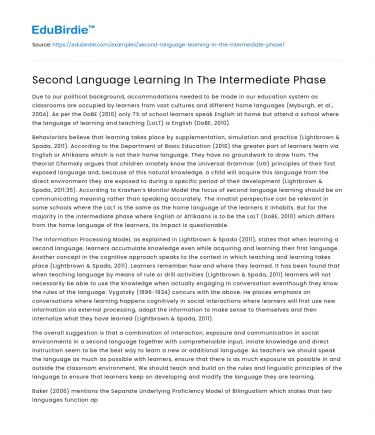Due to our political background, accommodations needed to be made in our education system as classrooms are occupied by learners from vast cultures and different home languages (Myburgh, et al., 2004). As per the DoBE (2010) only 7% of school learners speak English at home but attend a school where the language of learning and teaching (LoLT) is English (DoBE, 2010).
Behaviorists believe that learning takes place by supplementation, simulation and practice (Lightbrown & Spada, 2011). According to the Department of Basic Education (2010) the greater part of learners learn via English or Afrikaans which is not their home language. They have no groundwork to draw from. The theorist Chomsky argues that children innately know the Universal Grammar (UG) principles of their first exposed language and, because of this natural knowledge, a child will acquire this language from the direct environment they are exposed to during a specific period of their development (Lightbrown & Spada, 2011:35). According to Krashen’s Monitor Model the focus of second language learning should be on communicating meaning rather than speaking accurately. The innatist perspective can be relevant in some schools where the LoLT is the same as the home language of the learners it inhabits. But for the majority in the intermediate phase where English or Afrikaans is to be the LoLT (DoBE, 2010) which differs from the home language of the learners, its impact is questionable.
Save your time!
We can take care of your essay
- Proper editing and formatting
- Free revision, title page, and bibliography
- Flexible prices and money-back guarantee
The Information Processing Model, as explained in Lightbrown & Spada (2011), states that when learning a second language, learners accumulate knowledge even while acquiring and learning their first language. Another concept in the cognitive approach speaks to the context in which teaching and learning takes place (Lightbrown & Spada, 2011). Learners remember how and where they learned. It has been found that when teaching language by means of rule or drill activities (Lightbrown & Spada, 2011) learners will not necessarily be able to use the knowledge when actually engaging in conversation eventhough they know the rules of the language. Vygotsky (1896-1934) concurs with the above. He places emphasis on conversations where learning happens cognitively in social interactions where learners will first use new information via external processing, adapt the information to make sense to themselves and then internalize what they have learned (Lightbrown & Spada, 2011).
The overall suggestion is that a combination of interaction, exposure and communication in social environments in a second language together with comprehensible input, innate knowledge and direct instruction seem to be the best way to learn a new or additional language. As teachers we should speak the language as much as possible with learners, ensure that there is as much exposure as possible in and outside the classroom environment. We should teach and build on the rules and linguistic principles of the language to ensure that learners keep on developing and modify the language they are learning.
Baker (2006) mentions the Separate Underlying Proficiency Model of Bilingualism which states that two languages function apart from each other within a limited scope available to learn more.
The Balance theory highlights that a bilingual person’s languages will not interact with each other in the language part of the brain but cognitively there will be regular interaction between them (Baker, 2006). There is also mention of the Common Underlying Proficiency Model which is of the opinion that in Bilingualism there is a central area from which both languages function albeit that they are very distinct when communicating outwardly (Baker, 2006). This suggests that should we teach our learners by using both their home language and second language, the cognitive functioning and performance will be like teaching in one language as it hails from the operating same area.
As in Lightbrown & Spada (2011) speaking, listening, reading and writing in a first or second language will aid in the development of the cognitive system. But, first we as teachers need our learners to have a well matured second language. It will be important to encourage the use of their home language in schools as this will positively impact a learner’s performance.
The Threshold Theory suggests that if one or both languages a learner is learning in not sufficiently developed it will have negative impact on cognitive development (Baker, 2006). This theory speaks of three levels: Firstly, where neither of the two languages are at an age appropriate level. The next level is where one language is developed acceptably and the other not. On the next level both languages have matured to an age appropriate level (Baker, 2006). What is clear is that teachers need to be prepared to have learners on all three levels and able to adapt teaching accordingly.
Another important function of teachers is to provide support to learners on the different levels in terms context and cognitive appropriate tasks. The language proficiency of each learner must be matched to the curriculum tasks (Baker, 2006). Baker (2006) writes, learners need to move from Basic Interpersonal Communication Skills (BICS), where there is a need for contextual, visual and non-verbal support to a space where there is less context provided and a deeper cognitive proficiency exists in terms of the languages they learn. The latter is referred to as Cognitive/Academic Language Proficiency (CALP). Ideally learners should start moving into CALP before they start the Senior Phase.






 Stuck on your essay?
Stuck on your essay?

